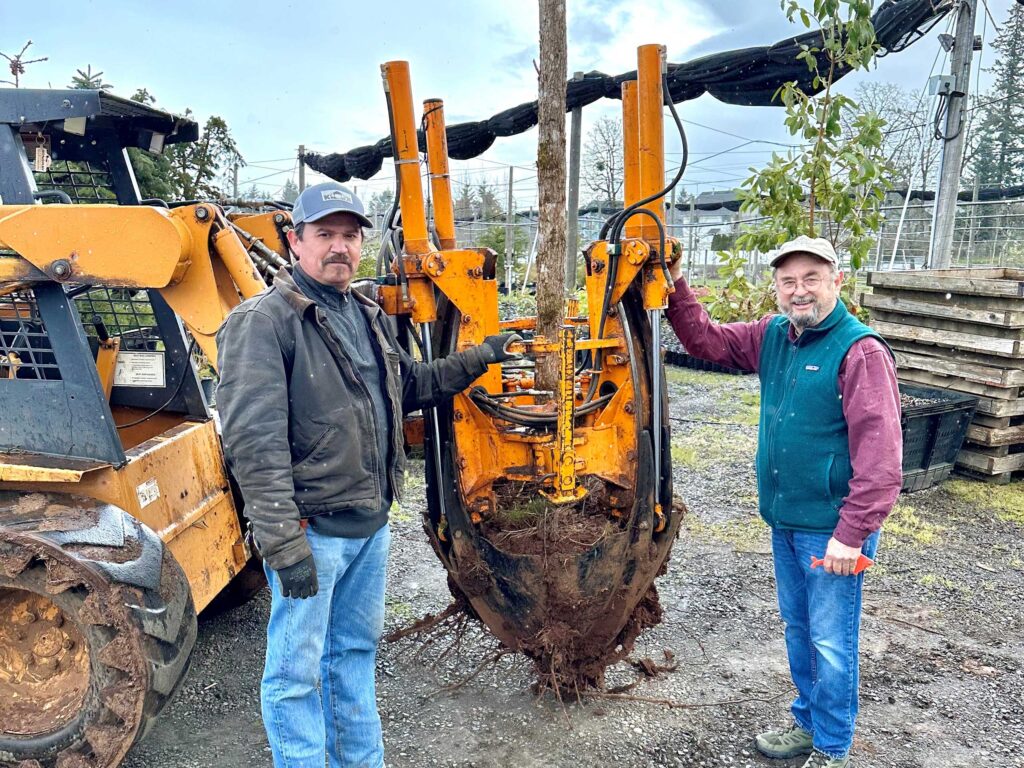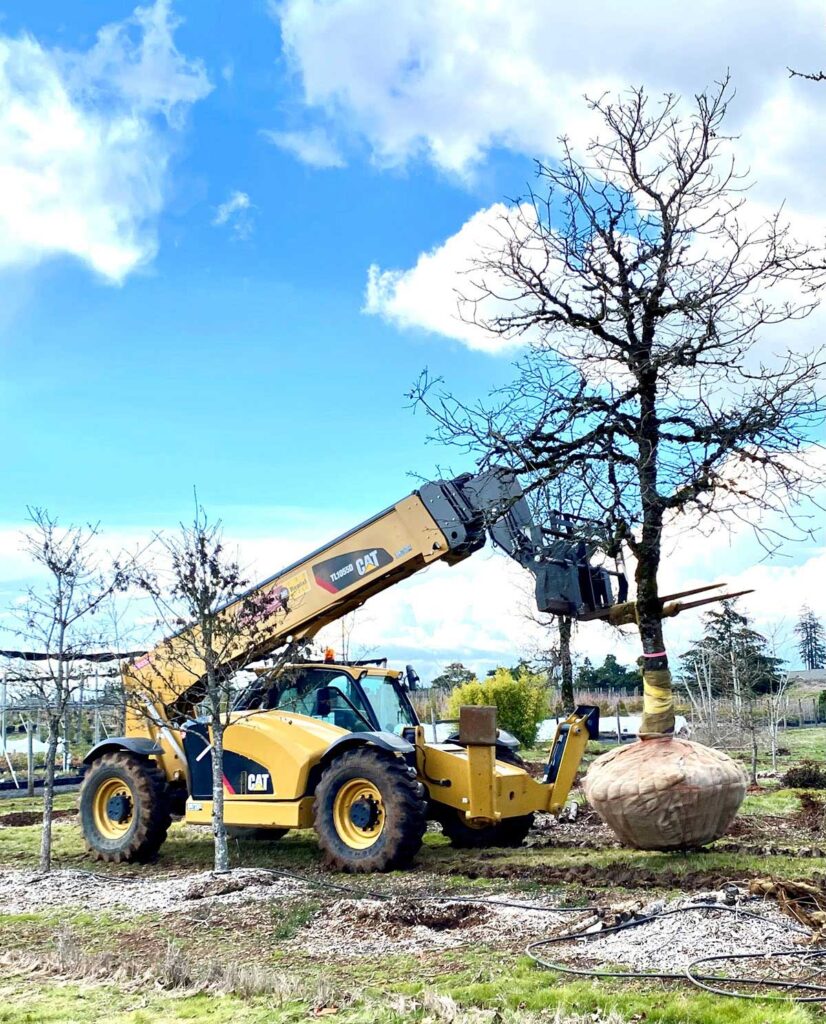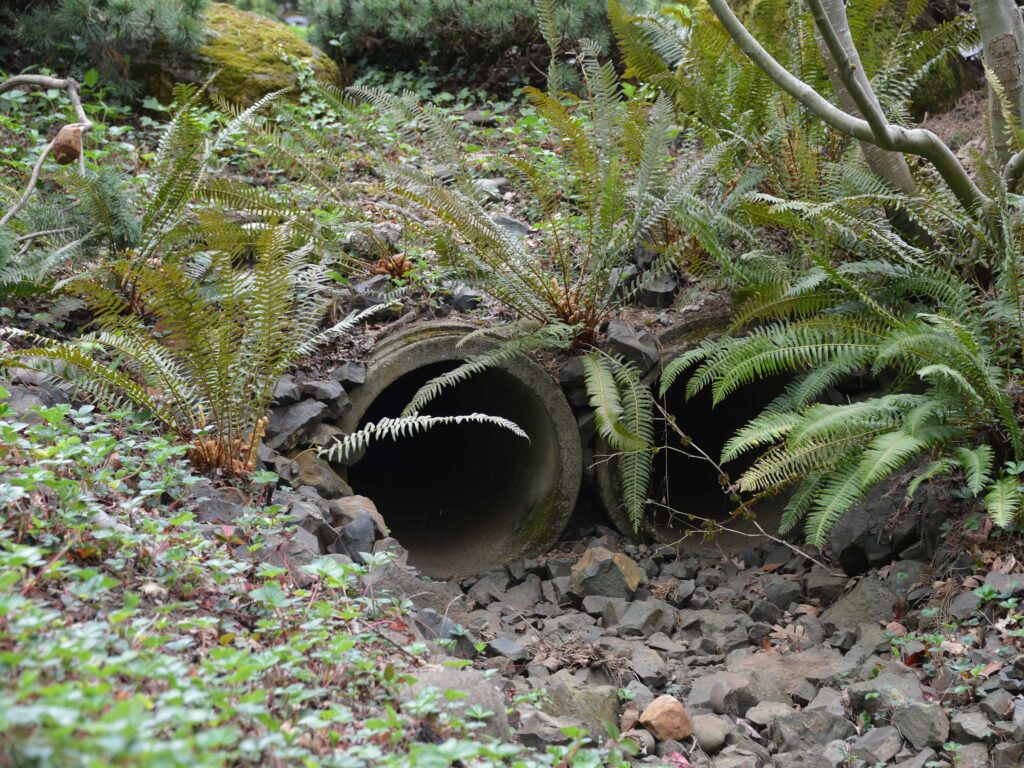Founded: 1983 by John D. Miller

Mahonia is a native plant species that plays an important role in Oregon’s ecosystems. These hardy, evergreen shrubs were used extensively by Native American tribes — as a food source, as a natural dye for textiles, and as medicine to treat a variety of human aliments, from digestive problems to skin issues and malaria.
Mahonia also serves as cover for small animals, provides food for fruit-eating mammals and birds, and produces fragrant, early-spring blooming flowers for pollinators like butterflies and bees.
Those beneficial attributes make Mahonia an especially appropriate name for the nursery operation in Salem, Oregon, started more than 40 years ago by John D. Miller, a local planner/developer who has helped pioneer the modern field of sustainable urban and environmental design.
Since 1980, Mahonia Nursery has specialized in growing its namesake Mahonia aquifolium, better known as “Oregon grape” — the state flower of Oregon — as well as M. compacta (compact Oregon grape), M. nervosa (dwarf Oregon grape), M. repens (creeping Oregon grape) and a few dozen other native plants of the Pacific Northwest.
“The nursery is an important part of our overall business, which is a family of companies that does lots of different things,” Miller said. “The nursery is sort of a green thread that goes through all of it.”
Adjacent to the nursery is Miller’s other grape-growing venture, Mahonia Vineyard, with its rows of Pinot noir, Pinot gris and Chardonnay vines. Nearby is Woodscape Glen, a community of multi- and single-family homes that Miller has planned, designed and developed since the 1970s. There’s also Schoolhouse Corner, an award-winning, mixed-use development of retail shops, office and restaurant spaces housed in a historic schoolhouse, the former Pringle Elementary School.
The latest addition to Miller’s sustainable legacy is Mahonia Crossing, a 313-unit residential complex by Community Development Partners that broke ground in March of 2023. Opening in stages starting this November, Mahonia Crossing will provide affordable housing for residents of all ages who earn 30–80% of the area median income (in Marion County, that’s $23,730 to $63,280 for a family of four).
The development received $25.2 million in Wildfire Direct LIFT funds from the state of Oregon, as well as state Agricultural Worker Housing Tax Credits designed to create housing for agricultural workers. A portion of Mahonia Crossing units will be prioritized for people who lost homes during Oregon wildfires and for agricultural workers and their families.
Mahonia Crossing occupies one of the final pieces of Miller’s masterplan for the 160-acre swath of land in south Salem he purchased in the 1970s. “I had saved this site for senior and/or affordable housing but realized that I did not have the expertise, resources or time to do the site justice, so I began to search for someone who did. I finally found Community Development Partners, who are a great match with their community values, proven abilities and environmental stewardship, all woven into a great design approach,” Miller said.

How it began
Miller started Mahonia Nursery in 1983, largely because he had difficulty finding ample supplies of the native plant material he wanted for Woodscape Glen, which he’d designed to be one of the first “green” multi-family developments in Oregon. “I laid it out with a hand compass and a machete, wearing a rubber suit because of the poison oak – pre-GPS tools!” Miller said.
While Miller knew how to plan and build homes, thanks to his master’s degree in environmental design from Stanford University (1971), propagating and growing native plants was another matter, so he consulted with Mark Krautmann of Heritage Seedlings & Liners.
“John’s early focus on Pacific Northwest natives was so prescient,” Krautmann said. “Many people flippantly dismissed Willamette Valley natives as a landscape fad back then. Not so, John. He staked his faith, funds and Mahonia Nursery’s future on our native trees, shrubs, ferns and wildflowers. Having gotten to know him rather well over 30 years, I feel confident to note that in his quiet but principled humility, John’s our unsung nursery hero.”
While siting homes for Woodscape Glen, Miller made it a priority to save as many of the native species as he could to preserve the natural woodland setting. This practice kickstarted the tree rescue program that has become a signature of his.
For Miller, sustainability includes preserving Oregon’s natural heritage by rescuing native oak trees that are destined for destruction. Under the direction of nursery manager Balta Lopez, oak trees are relocated to the nursery and carefully monitored for over a year before becoming available to others who share Miller’s passion for these majestic trees. Dozens of native oak trees were removed for the development of Mahonia Crossing and are now being nurtured for replanting at the building site once it is completed.
“We recently shipped a 40-foot, 12-inch diameter oak to Alaska Airlines’ new headquarters in Seattle,” Miller said. “We’ve gotten pretty good at taking trees out of harm’s way, and we’ve been able to increase our survival rate to almost 90%.”
Bioswales are another example of Miller’s pioneering work in environmental design. Miller designed one of the first bioswales in Salem, located in the Woodscape Glen development.
“With our first bioswale we had quite a time convincing the city that this was better than putting the stormwater in underground pipes. Later, for stormwater retention to reduce peak runoff flows, we made landscaped bioswales, which also serve as attractive water-cleansing features,” Miller said.

The present and beyond
Building bioswales was cutting-edge environmental design back in the 1970s, but it’s a common feature of urban development today — and one that growers of native plant material can partially thank Miller for.
“Bioswale work has become a way to sell plants,” Miller said with a smile.
Miller’s practice of saving established oaks trees has caught on, too. He’s one of almost 60 signatories of The Oak Accord, a consortium of Willamette Valley vineyards and other landowners who have vowed to retain oaks and enhance native habitats. (Miller is a founding member and past president of the Willamette Partnership board, which oversees The Oak Accord and other sustainability-oriented projects.)
Instead of bulldozing native oaks to prepare land for new vineyards or other development, Oak Accord signatories have pledged to preserve and enhance the ecosystem. It’s a small but vital way to save what’s left of the remaining 2% of Oregon white oaks that still stand today.
“The Oak Accord is becoming a real nursery-oriented program, because so many of the wineries are doing really elaborate tasting rooms and they buy nursery products for those,” Miller said. “In the old days, you just didn’t save the oaks. They thought there would be oak root fungus and birds landing in the trees, eating the grapes. Oaks and the grapes like the same dirt, same exposure, same soils, but now there’s a real harmony that actually is good for the wineries and the oaks … The fine wine consumer appreciates sustainability — in fact, they pay extra for it.”
Miller has also advocated for sustainability measures as a past-chair of the Oregon Sustainability Board, which oversees statewide efforts that enhance the environment, economy and communities. In addition, he’s chaired the board of SOLVE, an Oregon nonprofit that removes litter from neighborhoods and beaches, and plants native trees and shrubs for watershed restoration projects.
Currently, Miller serves on the advisory board of Portland Botanical Gardens (PBG). Co-founded by Sean Hogan of Cistus Nursery, the organization’s mission is to build a premier botanical garden in Portland, Oregon — one of the only major U.S. cities without such a destination. PBG’s vision for the botanical garden includes an accredited gardening school with horticulture and arboriculture certification programs, and biogeographic trial gardens.
“John is an amazing advocate for the environment,” Hogan said. “He has done so much for so many environmental causes and as an advocate for the nursery industry, native plants and the land around us.”
Miller believes in the ability of nature to improve physical and mental well-being. He is involved with and helps fund research that is developing data that shows that time in nature can improve human health. “Although we all know this is true, data can lead to a better understanding of why it is so and lead to more investment in our green infrastructure,” Miller said.
Miller has been inspired by the work of Japanese garden designer Hoichi Kurisu, who supervised construction of the Portland Japanese Garden and designed the Memorial Healing Garden at the Oregon State Penitentiary in Salem, Oregon. Miller is now involved with Kurisu’s latest project at the Coffee Creek Correctional Facility for women in Wilsonville, Oregon. “It’s another example of using nature to create benefits that extend beyond the prison walls,” Miller said.
Plants have played a major role throughout Miller’s personal life and professional endeavors, and he’s more optimistic than ever about their ability to inspire positive change. “Green activities are more profitable now — solar, wind, wave energy, working with the land instead of on it,” Miller said. “There are financial incentives now connected to what we should have been doing all along. That gives me optimism.”
His optimism is tempered by environmental challenges: “The increases in droughts, floods and fires — they’re all related to climate change,” Miller said. “I think the nursery industry is an important tool in increasing our resilience…. We won’t be able to reverse a lot of things that we’ve done, but if we can make our forests, farms and cities more resilient, we can mitigate some of what we’ve caused.”
Member Profile from the May 2023 issue of Digger magazine | Download PDF


